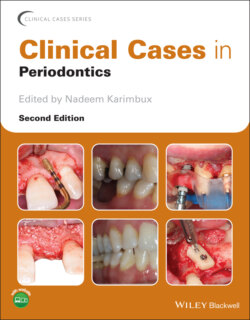Читать книгу Clinical Cases in Periodontics - Группа авторов - Страница 96
Intraoral Examination
ОглавлениеThe oral cancer screen was negative. His gingiva was pink, firm, with pointed papillae on the buccal aspect (Figure 1.6.1). However, the lingual and palatal aspects presented with signs of inflammation, with erythematous and edematous gingival margins. Adequate amounts of attached tissue were present around most teeth. Gingival recession was present at several sites (see periodontal chart for details). Supragingival and subgingival calculus could be detected on several tooth surfaces, particularly on the buccal surface of upper molars and lingual surfaces of lower incisors. There was generalized plaque accumulation. Saliva was of normal flow and consistency.
The periodontal chart presented in Figure 1.6.2 includes the following periodontal parameters: (i) probing pocket depth (PD) in millimeters; (ii) measurement from the cementoenamel junction (CEJ) to the free gingival margin (FGM) in millimeters (gingival recession was recorded as a positive value); (iii) clinical attachment level (CAL), which was calculated by adding the CEJ–FGM distance to the PD; and (iv) presence (1) or absence (blank) of bleeding on probing (BOP). Each clinical parameter was measured at six sites per tooth excluding third molars. Probing values were colored in black and red to highlight shallow (<4 mm), and intermediate to deep (≥4 mm) pockets. BOP was detected in 68% of sites, and the mean values for full‐mouth PD and CAL were 3.2 mm and 2.7 mm, respectively.
Figure 1.6.1 Clinical presentation of the case at initial visit.
Source: courtesy of Dr. Eduardo Sampaio and Dr. Marcelo Faveri.
Figure 1.6.2 Periodontal chart at initial visit.
Source: courtesy of Dr. Eduardo Sampaio and Dr. Marcelo Faveri.
